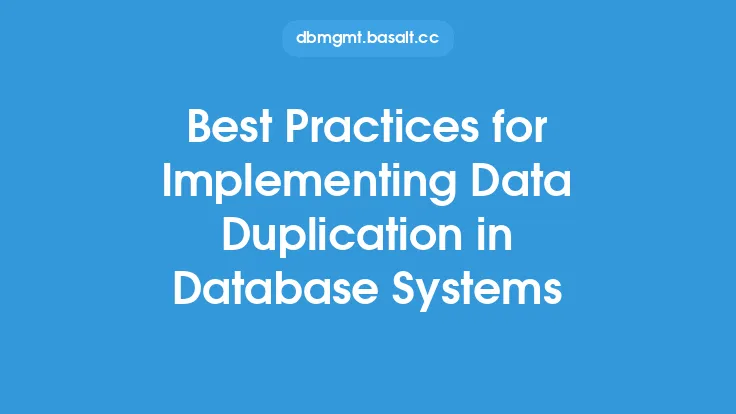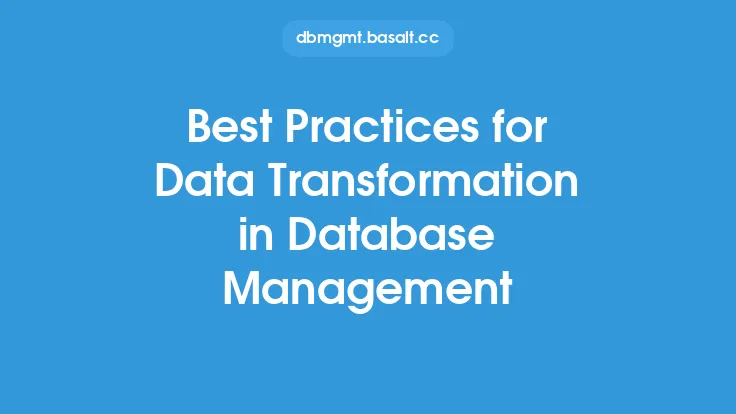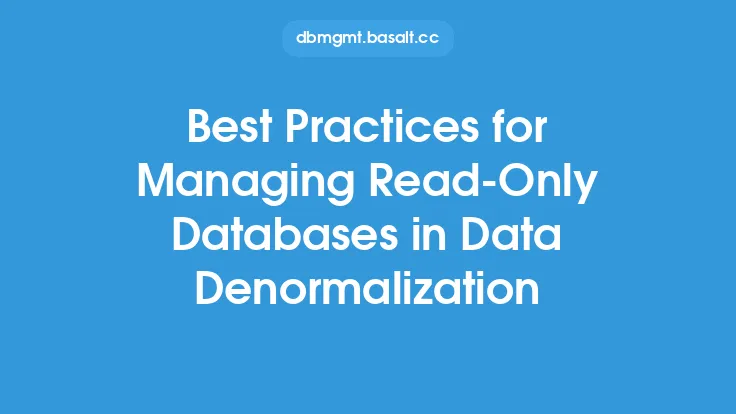When it comes to managing and analyzing data in database systems, data integration plays a crucial role. It is the process of combining data from multiple sources into a unified view, providing a single, accurate, and up-to-date picture of the data. Effective data integration is essential for making informed business decisions, improving data quality, and reducing data redundancy. In this article, we will discuss the best practices for data integration in database systems, highlighting the key considerations, techniques, and strategies for successful implementation.
Introduction to Data Integration Best Practices
Data integration best practices are guidelines that help organizations to design, implement, and maintain a robust and efficient data integration system. These best practices are based on industry standards, expert recommendations, and real-world experiences. By following these best practices, organizations can ensure that their data integration system is scalable, flexible, and able to meet the evolving needs of the business. Some of the key considerations for data integration best practices include data quality, data governance, data security, and data architecture.
Data Quality Considerations
Data quality is a critical aspect of data integration. Poor data quality can lead to inaccurate analysis, incorrect decisions, and a loss of trust in the data. To ensure high data quality, organizations should implement data validation, data cleansing, and data normalization techniques. Data validation involves checking the data for errors, inconsistencies, and completeness. Data cleansing involves correcting or removing errors, duplicates, and inconsistencies from the data. Data normalization involves transforming the data into a standard format to ensure consistency and accuracy.
Data Governance and Security
Data governance and security are essential for protecting sensitive data and ensuring compliance with regulatory requirements. Organizations should establish clear data governance policies, procedures, and standards to ensure that data is handled, stored, and transmitted securely. This includes implementing access controls, encryption, and auditing mechanisms to prevent unauthorized access, data breaches, and data tampering. Additionally, organizations should ensure that their data integration system is compliant with relevant regulations, such as GDPR, HIPAA, and PCI-DSS.
Data Architecture and Design
A well-designed data architecture is critical for successful data integration. Organizations should design their data architecture to be scalable, flexible, and able to accommodate changing business needs. This includes selecting the right data integration tools, technologies, and platforms to support the data integration process. Some popular data integration tools and technologies include ETL (Extract, Transform, Load) tools, data virtualization platforms, and data warehousing solutions. Organizations should also consider using data architecture frameworks, such as TOGAF or Zachman, to guide their data architecture design.
Data Integration Techniques and Strategies
There are several data integration techniques and strategies that organizations can use to integrate their data. These include ETL, ELT (Extract, Load, Transform), and data virtualization. ETL involves extracting data from multiple sources, transforming the data into a standard format, and loading the data into a target system. ELT involves extracting data from multiple sources, loading the data into a target system, and transforming the data into a standard format. Data virtualization involves creating a virtual layer on top of multiple data sources, providing a unified view of the data without physically moving or copying the data.
Data Mapping and Transformation
Data mapping and transformation are critical components of the data integration process. Data mapping involves creating a mapping between the source and target data structures, while data transformation involves converting the data from one format to another. Organizations should use data mapping and transformation tools to automate the data mapping and transformation process, reducing errors and improving data quality. Some popular data mapping and transformation tools include data integration platforms, data transformation languages, and data mapping software.
Testing and Validation
Testing and validation are essential for ensuring that the data integration system is working correctly and producing accurate results. Organizations should test their data integration system thoroughly, using a combination of automated and manual testing techniques. This includes testing the data integration process, data quality, and data transformation rules. Additionally, organizations should validate their data integration system against a set of predefined requirements and standards, ensuring that the system meets the business needs and expectations.
Monitoring and Maintenance
Monitoring and maintenance are critical for ensuring that the data integration system continues to work efficiently and effectively over time. Organizations should monitor their data integration system regularly, tracking performance metrics, data quality, and system errors. This includes using monitoring tools, such as data integration monitoring software, to track system performance and identify potential issues. Additionally, organizations should perform regular maintenance tasks, such as data backups, system updates, and software patches, to ensure that the system remains stable and secure.
Conclusion
In conclusion, data integration is a critical component of database systems, providing a unified view of the data and enabling organizations to make informed business decisions. By following best practices for data integration, organizations can ensure that their data integration system is scalable, flexible, and able to meet the evolving needs of the business. This includes considering data quality, data governance, data security, and data architecture, as well as using data integration techniques, strategies, and tools to integrate the data. By testing, validating, monitoring, and maintaining their data integration system, organizations can ensure that their data integration system continues to work efficiently and effectively over time, providing a solid foundation for business success.





